CSotD: Twitterfall, w/ unsolicited advice for cartoonists
Skip to comments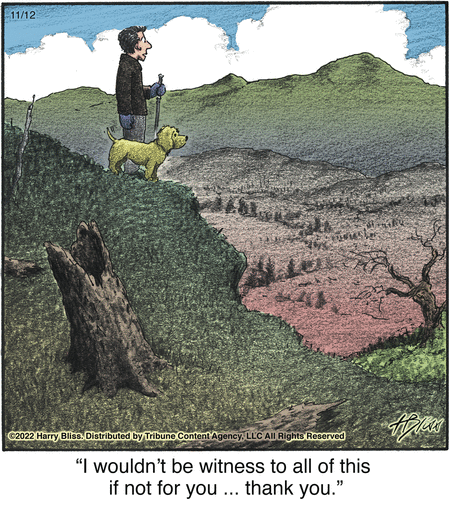
I particularly like this Bliss (Tribune), because my life includes taking the dog for a romp twice a day which, combined with my 35-hour work week, reduces me pretty much to being her chauffeur and, yes, I’m grateful that she gets me out of the house.

Here’s the snippet I’m posting on-line today, as an invitation for people to come here. We’ll get to that later.
Harry Bliss bought JD Salinger’s place about 20 miles south of here, which may explain why so many of his cartoons have peaceful, sylvan settings.
I didn’t know Salinger lived around here until he died, but then stories emerged of how his neighbors protected his privacy by sending literary groupies on wild goose chases that never led to his home. Apparently, everyone in Cornish knew Jerry, who was not a hermit and came into town regularly, but they respected his desire for privacy. Good neighbors!
Which brings us to the looming death of Twitter, the impending demise of print newspapers, and the need for cartoonists to straddle that fence between being essentially private people and still wanting to make a living doing what they love.
Salinger had enough royalties that he didn’t need to fret over money, and there are some massively successful cartoonists, too, and that’s good for them, but the starving artist is more typical.
F’rinstance, I’ve paid my bills through writing for half a century, but it was work-for-hire, not the creative stuff, and I know that even writers with book contracts live in a world of chicken one day and feathers the next.
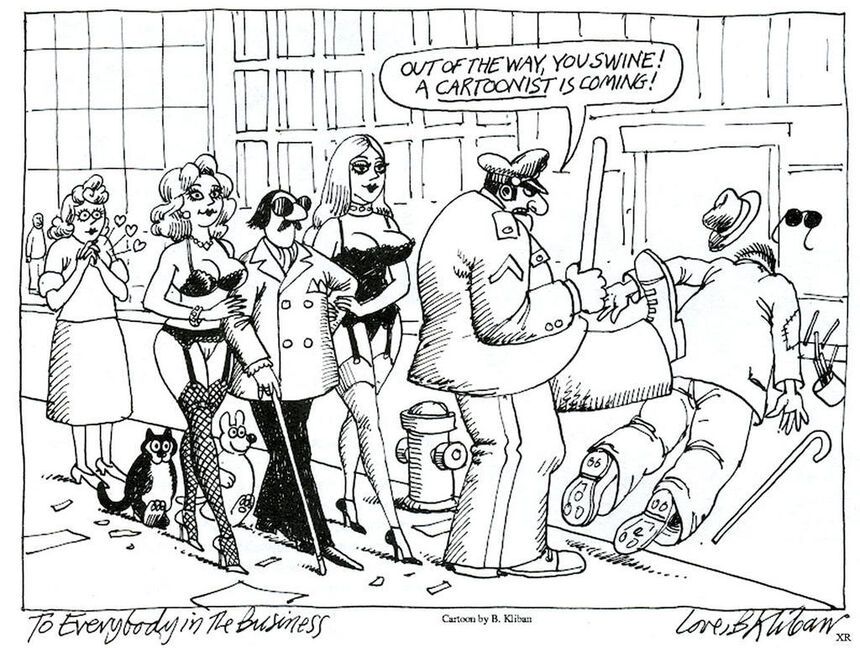
Which is why this Kliban classic is so often posted by cartoonists. It wouldn’t be funny if it were true, but, as it is, it’s hilarious and becoming moreso by the day.
No artist — cartoonist or painter or musician or actor or dancer — should expect a life of luxury, and, if you’ve never read W. Somerset Maugham’s Of Human Bondage, you should. You can even load it on your Kindle for free, since he’s long dead and won’t mind.
Or go see La Boheme or, for younger folks, Rent.
However, brace yourself for the fact that the starving artist thing is a lot more romantic in books and on stage than it is in real life.
Still, if it’s what you do, it’s what you do, and if you can’t afford to do it full-time, you just need to stretch the week and squeeze it in somewhere.
The alternative is to give up, and that’s even less romantic.
Lee Enterprises’ chain-wide massacre of comics pages, and an even more dire slashing from News Corp in Australia leaves a lot of cartoonists with greatly reduced income, if it leaves them with any income at all. As this darkness descends, the question isn’t how to become wealthy but how to survive.
So what’s that got to do with Twitter?
Juxtaposition of the Day
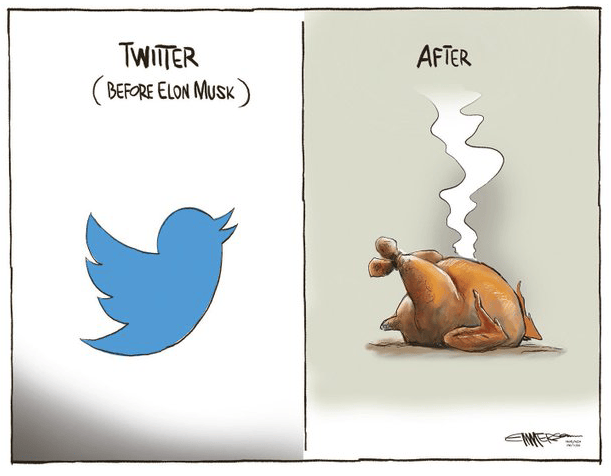
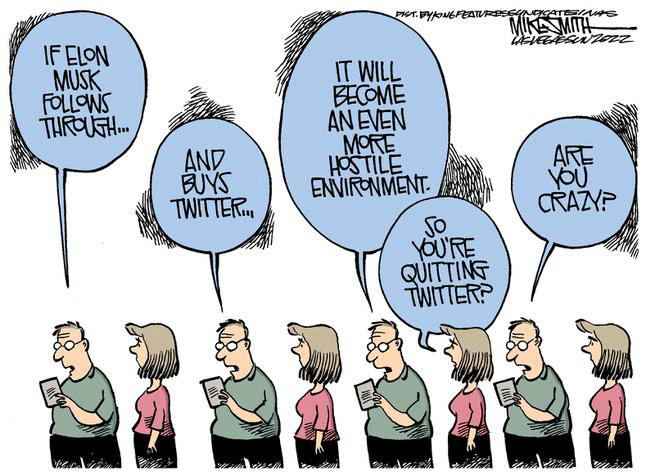
Elon Musk’s destruction of firewalls like verification, combined with his chaotic management style and constant meddling, makes Emmerson’s prediction seem likely: He’s making the platform unusable, despite, as Smith notes, people’s reluctance to abandon it.
The relevance for cartoonists is that, because of the looming destruction of the print market, they need to entirely change their marketing approach.
Until now, the goal — whether by cartoonists or their syndicates — was to sell their cartoons to editors.
Readers had influence on those decisions back in the Thirties, when Kliban’s cartoon might have been less of a fantasy. Editors and publishers were far more in touch with their readership and people like George McManus and Bud Fisher truly were celebrities.
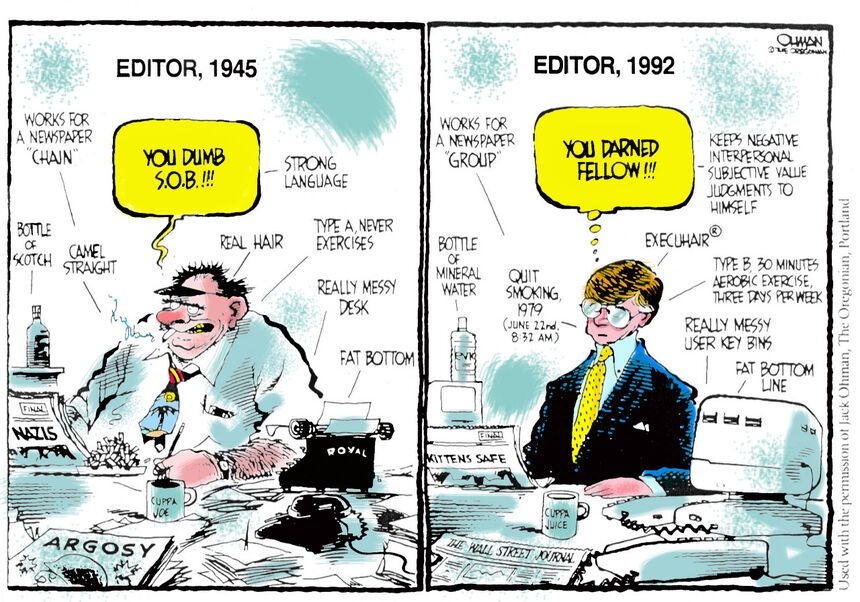
But, as this classic Jack Ohman cartoon illustrated 30 years ago, the installation of button-down corporate-approved editors left newspapers in the hands of people whose interest was in pleasing a distant HQ, not their local readers, and who were far more skilled at spotting split infinitives than at picking up on metaphors, sarcasm and creative hilarity.
They didn’t, for example, understand why a strip like Retail would appeal to potential readers under 30, and they continue to persist in thinking that any cartoon with black characters is the same as any other cartoon with black characters, a form of blind tokenism highlighted in a February 2008 protest, of which these are a sample:
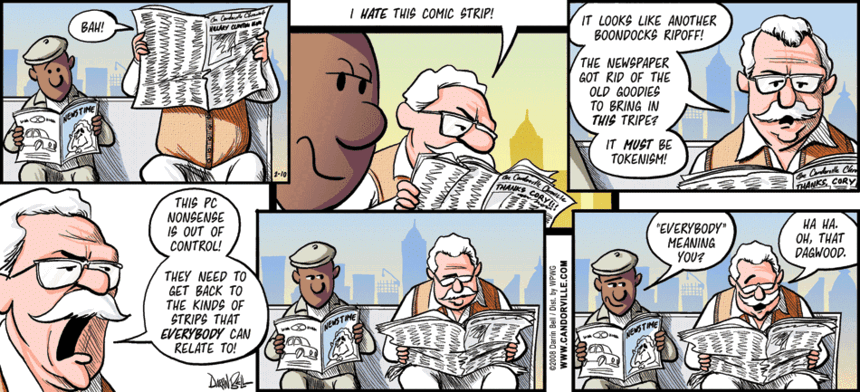
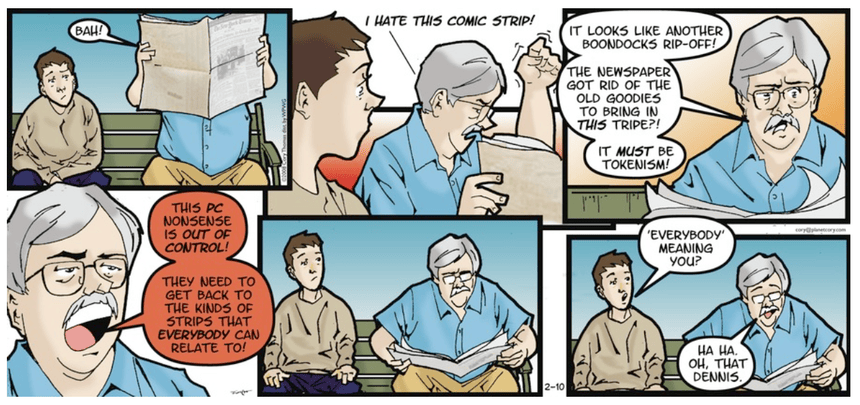


I was, for a time, the target of syndicate sales, and when they had a new strip to market, I wasn’t approached with “Here’s the audience it will appeal to” but, rather, “It’s by a prize-winning cartoonist,” which is an appeal to more of the same, which is the correct approach in a corporate-driven world in which readers are the product, not the clientele.
But with the decline of print markets, the task of selling a strip becomes a matter of appealing directly to readers.
The popularity of memes is clear evidence of an appetite for graphic humor and commentary, though it has been lovely to make a wholesale appeal to an editor who represents 50,000 readers rather than having to assemble the crowd yourself.
Still, that’s the coming mission, and, as long as you don’t mind driving a six-year-old car and eating beans and rice a few times a week, it’s not impossible.
And, yeah, this is one helluva bad time for Twitter to crap out as a way to reach those individual readers.
However, as the old folks say, “What can’t be cured must be endured,” and the loss of a major platform is just one more factor cartoonists have to bear in mind moving forward.
Some suggestions:
I’m on both Mastodon and CounterSocial, but the clumsiness of interactive response there seems off-putting. Still, they exist and you’d be silly not to make use of them, along with Instagram and wherever else you can find a spot to hang your work.
And former Twitter exec Jack Dorsey is preparing a new platform which is worth keeping an eye out for.
Facebook, meanwhile, remains a substantial presence, but, dear lord, it’s a cluttered mess. My solution is that I have a personal account that I follow on Firefox, and a second more comics-oriented account that I follow on Brave. The first is joyfully packed with friends’ and relatives’ posts of their dogs, grandkids and cranberry bread recipes, the second is curated to try to keep clutter to a minimum.
But here are some tips, wherever you choose to work the magic:
- Post teasers, not your finished cartoons. Crop and post a tantalizing snippet (see above), linked to the final piece on a page you control. Posting the entire cartoon on social media is giving it away for free, and that’s not a sensible goal.
- Make sure the page you send people to is open. That’s no problem if you’re on GoComics, Comics Kingdom or somewhere similar, but don’t make them bump their heads on a paywall, either at your home paper or at your own Patreon. They won’t come back.
- Make sure your page is regularly updated and tended. If you aren’t hand-posting your work, check daily to make sure your bot did what it was supposed to. People won’t keep visiting a page that isn’t regularly refreshed.
- Don’t be afraid to ask for their support. That’s “Salesmanship 101” — No matter how good your pitch, people don’t pony up without prompting. And consider some self-published books and other merch, too. Selling isn’t the fun part, but it’s how you pay the bills.
Mostly, remember that being a starving artist beats hell out of starving without the consolation of art, and that your self-image shouldn’t be bound in money anyway.
NOTE: You’ll still see my daily reminders and links on Twitter for now, but you can also find me here:
Facebook: https://www.facebook.com/mikecsotd.peterson
Counter Social:@CSotD@counter.social
Mastodon: mas.to/@CSotD
Comments 4
Comments are closed.